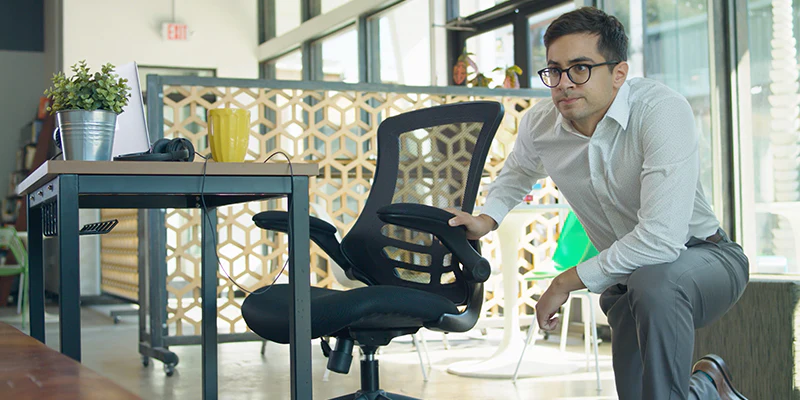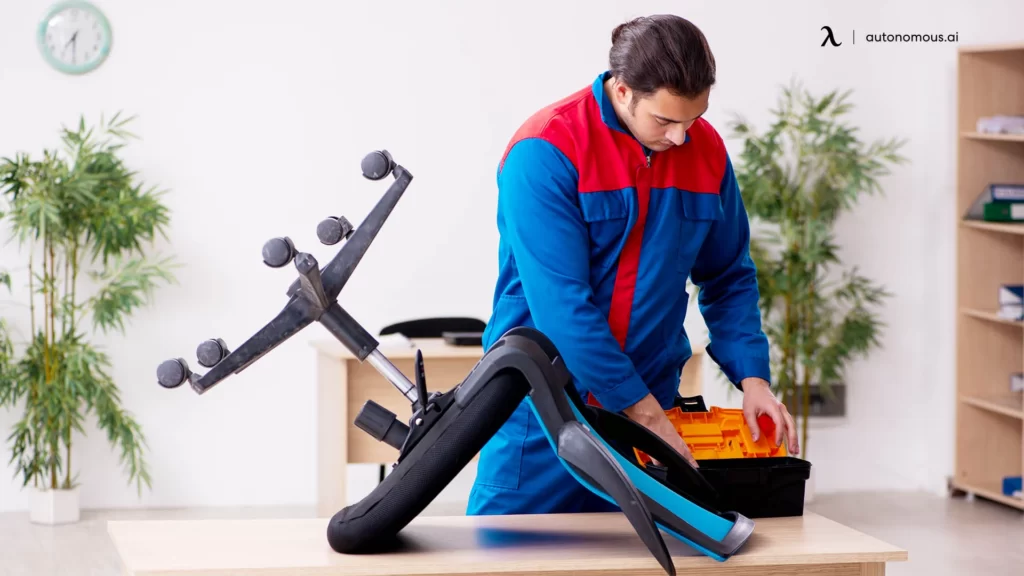
A “sink” feel is common in office chairs due to the pneumatic valve used to adjust the seat platform. A faulty office chair is one of that classic, seemingly minor issues that can quickly affect your productivity levels. If your office chair sinks every time you sit on it, don’t worry. We have some carefully researched solutions that we are sure will fix your office chair.
Can the Wrong office chair Height Cause Health Issues?
To achieve the best level of leg comfort, you need to balance seat height and knee angle. When sitting, your knees should be at a 90-degree angle to your feet, and this can only be achieved when your feet are touching the ground. Otherwise, your legs will be swollen.
You may experience lower back pain while sitting in a low office chair.
Still, taller men often have the hardest time finding the right office chair, even with full height adjustment. Sometimes long legs force you to cross your legs or to partially or fully straighten your legs, depending on the height of the office chair. As a result, there is pressure on the limbs.
As a result, tingling, numbness, or straining may occur in the lower and middle extremities. Plus, the tight comfort space in the legs can end up distracting you from your entire pose, which can indirectly hurt your lower back, hips, and thighs. Therefore, the right height will make your legs more comfortable.
Why Do Office Chairs Sink?
A sunken office chair doesn’t mean the entire chair is broken. In fact, the reason why this happens is simple. The office chair cylinder lost lift.
The office chair cylinder is the part of the office chair that connects the base to the seat. That’s why we can adjust the office chair up and down. There is nitrogen in the office chair cylinder. So when you pull the office chair lever, the nitrogen gas switches the chambers inside the cylinder, making it move up and down. More technical details about gas springs can be found here.
Over time, after excessive use of the office chair, the seals in the cylinders begin to wear and leak. Therefore, it is the cylinder that causes the office chair to sink.
Steps to Fix Office Sinking Chair

Since having a sinking chair is so common, do-it-yourself solutions can help solve the problem, in no time. However, you need to know the steps to accomplish these. Read on to find out more.
1. Use hose clamps
One of the most common solutions for securing office chairs is to use hose clamps. It’s easy, inexpensive, and you can do it at home in minutes — you don’t even need to disassemble the office chair.
There are other options, such as using PVC pipe, but hose clamps are a favorite of many. To use, remove the cylinder and slide the plastic skin off the office chair.
Most office chair components have a visible plastic skin covered with a metal tube that you need to expose to successfully secure the seat. So slide the plastic skin off.
2. Adjust the Office chair to the height you want
The second step is crucial because you may not be able to change it later. Once the metal tube is exposed, adjust the seat until it has the right height.
A good way to know the correct height of an office chair is to use your knees as a reference. When you stand up, the seat should be flush with them.
In some cases, the computer office chair is so damaged that it cannot support it even when no one is sitting on it. If this happens, set it aside to complete the process.
3. Grab the gas cylinder and wrap it with a hose clamp
Find the hose clamp. You can get it at any hardware store. Once you have it, loosen its screws. It can help you fix your office chair.
After pulling one end of the strap, wrap the clip around the metal cylinder. You shouldn’t be screwing it, so make sure you’ve done each step of the process correctly before continuing.
Another suggested step for securing an office chair is to improve the grip of the clamps, as the clamps need a very tight grip to support the office chair. To do this, grab the cylinder and wrap it in a strip of rubber or tape.
4. Tighten the hose clamp
If the rest of the steps are done correctly, it’s time to tighten the hose clamp as much as possible.
Grab the top of the cylinder and slide the clamp up. Make sure the ergonomic chair has the proper height before completing this step.
Once you’ve made sure everything is in order, pull on the hose clamp. Then, turn the screw to tighten it.
5. Test office chair
Now that you’ve learned how to fix an office chair that won’t sit, it’s time to find out if it works.
After tightening the clamps, the office chair should be able to slide over the clamps. In other words, it shouldn’t continue to sink despite your efforts.
Sometimes, even after trying to adjust it correctly, the office chair can be at the wrong height. If this happens, don’t worry. Just grab the clamp and move it higher or lower on the cylinder.
Also, sometimes the clamps can slip off. In this case, grab a strip of rubber and fasten it to tighten again.
How To Prevent Further Sinkage
Once you’ve fixed your ergonomic office chair, the last thing you want to do is go through all the trouble again. While every part wears out over time, there are some simple precautions you can take to prevent or delay sinking:
- Treat your office chair gently. Your office chair is a professional tool that usually costs a lot. Be careful when sitting and getting up. If you have children or pets around, be sure to set expectations for how you will move around your home office chair.
- Adhere to weight restrictions. Cylinders come in different categories (see BIFMA’s explanation), and it’s important to stay within the weight limit for your specific office chair.
- Buy a plastic cover. Keep dust and debris from interfering with the cylinder by adding such an affordable plastic skirt.
- Clean office chairs regularly. Regular cleaning goes a long way in keeping your office chair running smoothly. For more information on cleaning office chairs, see SitWorkPay’s full guide.
Conclusion
Office chairs use pneumatic cylinders to control the height of the chair through pressurized air. The cylinders on most seats fail within a few years, usually because the seals are damaged and cannot maintain pressure. Try these easy DIY methods to secure your chair at a decent height.
